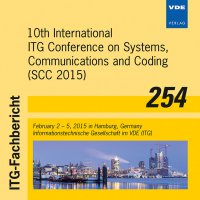Improved Code Construction for Synchronization Error Correction
Conference: SCC 2015 - 10th International ITG Conference on Systems, Communications and Coding
02/02/2015 - 02/05/2015 at Hamburg, Germany
Proceedings: SCC 2015
Pages: 6Language: englishTyp: PDF
Personal VDE Members are entitled to a 10% discount on this title
Authors:
Buttigieg, Victor; Briffa, Johann A. (Dept. of Comm. & Comp. Eng., University of Malta, Msida MSD 2080, Malta)
Abstract:
Minimum distance (MD), maximum likelihood (ML), and maximum a posteriori (MAP) decoding is considered for synchronization error correcting (SEC) codes with known codeword boundaries when transmitted over the Binary Substitution, Insertion and Deletion channel. It is shown that MD decoding is sub-optimal, unlike ML or MAP decoding. Based on ML and MAP decoding, a new measure called the Change Probability is defined for SEC codes. A simulated annealing algorithm is then used to design new codes based on this measure. It is shown that the symbol error rate performance of these new codes is marginally better than that of Varshamov- Tenengol’ts single error-correcting codes and significantly better than Helberg multiple-error correcting codes. Compared to a double error-correcting Helberg code of length 17 the symbol error rate performance is improved by an order of magnitude for the same decoding complexity. To improve performance when codeword boundaries are not known, we use Time Varying Block (TVB) codes consisting of a set of SEC codes applied in a random sequence. Finally, a TVB code is used as an inner code in a concatenated system with a standard error-correcting outer code, improving performance over a similar system that uses an improved watermark string in the Davey-MacKay construction.


